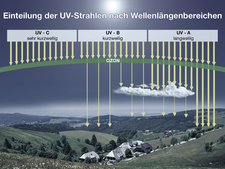-
Topics
subnavigation
Topics
Electromagnetic fields
- What are electromagnetic fields?
- Static and low-frequency fields
- Radiation protection relating to the expansion of the national grid
- High-frequency fields
- Radiation protection in mobile communication
Optical radiation
Ionising radiation
- What is ionising radiation?
- Radioactivity in the environment
- Applications in medicine
- Applications in daily life and in technology
- Effects
- What are the effects of radiation?
- Effects of selected radioactive materials
- Consequences of a radiation accident
- Cancer and leukaemia
- Genetic radiation effects
- Individual radiosensitivity
- Epidemiology of radiation-induced diseases
- Ionising radiation: positive effects?
- Risk estimation and assessment
- Radiation protection
- Nuclear accident management
- Service offers
-
The BfS
subnavigation
The BfS
- About us
- Science and research
- Laws and regulations
- BfS Topics in the Bundestag
- Links
What is UV radiation?

![]() Classification of UV rays according to wavelength bands
Classification of UV rays according to wavelength bands
Ultraviolet (UV) radiation covers the wavelength range of 100 nanometres (nm) to 400 nm. It is the highest-energy form of optical radiation. UV radiation is not visible to humans and cannot be perceived by the other senses either. UV radiation is subdivided into the following wavelength ranges:
- UV-A (400-315 nm wavelength)
- UV-B (315-280 nm wavelength), and
- UV-C (280-100 nm wavelength).
UV-A radiation is adjacent to the visible light spectrum, covering wavelengths from 315 to 400 nm, that is the long-wave range of UV radiation. UV-B radiation, also referred to as "mid-UV", ranges from 280 to 315 nm. UV-C radiation has the shortest wavelength (100 to 280 nm) and therefore is the most energetic UV range. UV-C radiation is directly adjacent to the range of ionising radiation. The shorter the wavelength, the more energetic the radiation and the more damaging the effect.
Solar UV radiation
The so-called "natural", or "solar" UV radiation is ultraviolet (UV) radiation from the sun. Solar UV can penetrate the earth’s atmosphere, depending on the wavelength.
- UV-C: this highly energetic UV radiation is completely absorbed by the earth’s upper atmosphere. Solar UV-C radiation, therefore, will not reach the earth’s surface.
- UV-B: depending on the status of the ozone layer, the energetic UV-B radiation is also filtered out by the atmosphere, although not completely absorbed: up to about ten per cent of the energetic UV-B radiation still reach the earth’s surface. Damage to the ozone layer increases the fraction of UV-B reaching the earth’s surface.
- UV-A: in contrast to UB-B and UV-C rays, the longer-waved UV-A radiation reaches the earth largely without hindrance.

![]() The intensity of natural UV radiation reaching the earth’s surface depends on a number of factors
The intensity of natural UV radiation reaching the earth’s surface depends on a number of factors
The intensity of natural UV radiation reaching the earth’s surface depends, above all, on the latitude and solar altitude. The closer you get to the equator, the stronger the UV radiation. UV radiation is stronger in summer than winter.
The height above sea level also plays a role: radiation increases with the height, for example in the mountains. UV radiation is weaker with heavy cloud cover than under clear sky or light cloud cover. Radiation at a given place is stronger at noon than in the morning or evening. Water, sands and snow reflect UV radiation like a mirror, thus strengthening it.
Environmental parameter UV radiation
Solar UV radiation has become an important environmental parameter, which is subject to continuous monitoring worldwide, not least because of the ongoing processes in the ozone layer of the atmosphere. The daily peak of erythemal UV radiation expected to reach the earth’s surface is described by the internationally standardized UV Index (UVI). In cooperation with Umweltbundesamt (UBA: Federal Environment Agency), Deutscher Wetterdienst (DWD: Germany’s National Meteorological Service) and other associated institutions, the BfS is operating a nationwide network of solar radiation monitoring stations (UV-Messnetz) to determine the UV Index. Current UVI measurement values and forecasts are available on a daily basis during the summer half-year.
Individual exposure to natural UV radiation and related health risks largely depend on each individual’s behaviour. Exposure and risk, therefore, are individually controllable. Appropriate protection measures should be taken on any outdoor activity, particularly during holiday time.
Artificial UV radiation
There are many sources of artificial UV radiation in everyday life since UV radiation is used in many technical and medical applications. Use of UV radiation for cosmetic purposes, for example in sunbeds, is a matter of great concern from the radiological protection point of view. In terms of its effects, the artificially generated UV radiation does not differ from natural UV radiation. Using sunbeds, therefore, may involve acute and chronic damage to the eyes and skin similar to those known from increased exposure to the sun. It has been proven that UV radiation used in sunbeds is carcinogenic to humans in the same way as solar UV radiation. It is not recommended to use sunbeds.
In Germany, operators of indoor tanning salons are prohibited by law from allowing under-18s to use sunbeds. Trained staff has to be present in indoor tanning salons in order to advise customers about the risks associated with UV radiation, provide individual skin type determination, and prepare individual dosage schemes based thereupon. The operation of tanning salons in Germany is subject to the "Gesetz zum Schutz vor nichtionisierender Strahlung bei der Anwendung am Menschen" (NISG; Act on the protection against non-ionising radiation used in humans) and the "Verordnung zum Schutz vor schädlichen Wirkungen künstlicher ultravioletter Strahlung" (UV-Schutz-Verordnung, UVSV, Ordinance concerning sun beds).
State of 2017.11.23


